Training A Puppy For Grooming
Training a Puppy for Grooming By Janice Jones |Last Updated 12-1-2019
Have you ever watched a gorgeous show dog being brushed by his owner or handler while lying serenely on a grooming table – barely moving, yet giving the impression that he was enjoying every minute of the pampering?
Each stroke of the brush seems to relax both the brusher and the brushee to the point where both are oblivious to any outside noise or activity. Both are “in the zone” so to speak.
Wow
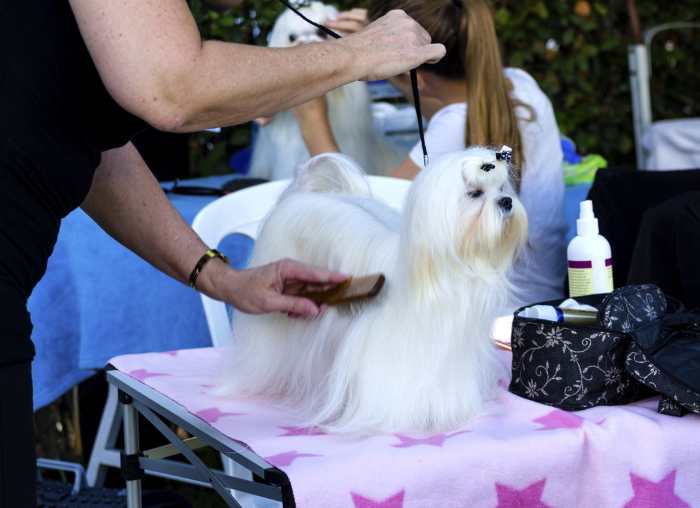 Training a Puppy for Grooming
Training a Puppy for GroomingWas that show dog born with some unusual genes that permitted him to love grooming from day one?
Unlikely.
That lovely show dog was once a puppy with a short attention span and an agenda that didn’t include hours of brushing. Just how did that handler transform a wiggly impatient puppy into an adult that seemingly loved all that grooming has to offer?
Training a Puppy to enjoy grooming is just one of those tasks that go along with puppy care and training. According to Pat Hastings, author, breeder, handler and judge, puppies need to be able to tolerate grooming even if they don’t like it.
Even if you chose a short-haired breed that won’t require hours of your time to groom, puppies still need a bath, nail clip and teeth brushing. Just how can you accomplish all of these tasks when the puppy won’t sit still for a second?
When you think about a training, you probably think your task is complete after housebreaking and basic commands, but grooming is important not only for looks but for the health of your dog.
Why Train a Puppy for Grooming?
Training a puppy to cooperate and enjoy a grooming session is a must.
At the very least, a puppy will need to be:
- Brushed
- Bathed
- Nails Clipped
- Teeth Brushed
- Ears Checked and Cleaned
When that puppy is a member of a long-hair breed such as a Maltese, Havanese, Shih Tzu, Lhasa Apso, just to name a few, that list of grooming tasks can grow exponentially.
These small breed dogs will require a great deal of grooming attention over their life span. Most puppies are not born knowing how to behave when groomed. Rather, puppies must be taught to stand, sit, or lie for grooming because if they do not you will find yourself trying to brush a moving target – a frustrating experience for you and a potentially dangerous one for your puppy.
Just like small children, puppies are much too busy to sit, stand, or lie down for grooming. The trick with puppies is to convince him that a grooming session is highly desirable and there are rewards for cooperating.
Training a Puppy for Grooming and a Word About Supplies
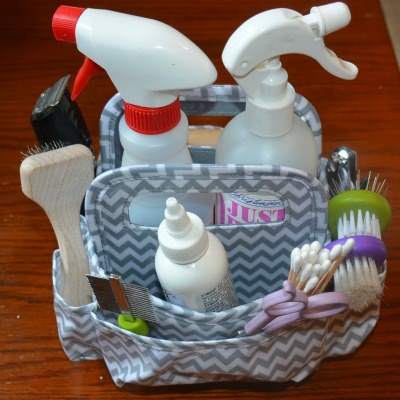 Training a Puppy for Grooming: Supplies
Training a Puppy for Grooming: SuppliesThe sky’s limit when it comes to puppy grooming supplies. A new puppy doesn’t need much but it is a good idea to look ahead and plan accordingly. In this article, I have tried to touch on the major grooming tasks but there are many more depending on the breed of dog.
Depending on your breed of dog, training a puppy for grooming may also mean that you will be introducing some of the following:
- Conditioning spray mist
- Scissors for removing hair from sensitive areas
- Hair clippers to remove hair from paw pads, sanitary clips
- Ear cleaner, powder and hemostats for removing hair from inside the ears
Training a Puppy for Grooming
There is always that outlier puppy — the one who has decided at an early age that he wants no part of grooming. Luckily they are few and far between. You may even be thinking right now that your puppy falls into this category.
But, before you throw in the towel, take a look at some of the tips that I have used successfully with puppies who run at the sight of a brush.
Tips For Training a Puppy for Grooming
- Use frequent short session (sometimes just a few minutes)
- Train your dog to stand, sit, lie down on a table, counter or other hard surface as you would train other basic commands
- Touch areas of the puppy’s entire body including paws, tail and under arms when you are playing or cuddling with him
- Use a soft child size brush initially
- Use lots of praise, kisses and treats
- Never allow your puppy to decide when the grooming session is finished (more about that in a moment)
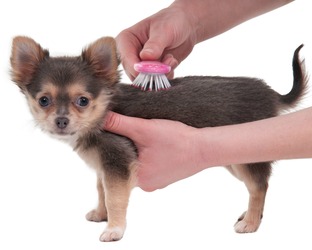 Training a Puppy for Grooming By Using a Soft Puppy Brush
Training a Puppy for Grooming By Using a Soft Puppy BrushWhere Should You Groom Your Puppy?
There are three locations that can be used to groom a puppy:
- On the Floor
- On a hard surface such as a table or coutertop
- On your lap
Advantages of Using a Hard Surface (Table)
If you have a long haired breed, you will ultimately want to train your dog to sit, stand, or
lie down on a hard surface such as a grooming table or kitchen counter. Unless
you plan to show your dog or keep a long haired breed in full coat, a
commercial grooming table is not necessary, but very helpful. The other option is to groom him on the floor or on your lap.
It is
easier in the long run to groom a dog on a table rather than hoping they will
behave on your lap. You have the most
control over the grooming experience if you use a grooming table, and a small
one does not take up much space and is easy to transport if you decide you want
to get into showing.
Otherwise, use a
counter or table with a height comfortable to you so you do not need to bend
over in an awkward position.
When you think about it, sitting or standing on a grooming
table can be a scary proposition to a small dog. The table is at the correct height for you,
but it must seem like a mountaintop to a small dog.
The reason I suggest putting the puppy on a
surface other than your lap is that he will eventually need to stand on a table
at a veterinary office. If you plan to
take him to the groomers, he will need to stand on the groomer’s table.
If he
has already experienced this in the comfort of your home and in your presence,
these trips to the groomer and vet will be much less stressful. A small towel or pad placed on the counter
helps the puppy feel secure.
Grooming a Puppy on the Floor
If you are worried about a puppy jumping off of a table, the next best place to groom is the floor. There’s no chance of injury and if you want your children to learn to brush their puppy, the floor is a good choice.
The disadvantage is that the puppy is much more likely to escape. Once the puppy learns to get away, it will become a game where you are not likely to win.
If the floor is your best choice, consider attaching a small leash that will keep the puppy from running too far.
Grooming a Puppy on Your Lap
This is the most popular way to familiarize a puppy to grooming is while he’s comfortably resting on your lap. If the puppy is a budding young lap dog, this could be a perfect choice. He’s comfortable. You’re comfortable. A match made in heaven.
But, brushing and combing a puppy’s back and head may be easy while he’s resting comfortably, other parts of body may be difficult to reach. Training a puppy for grooming on the table may be a better option.
Preliminary Steps for Training a Puppy for Grooming
- Teach him to stand on a table or counter
- Get him used to being touched on the face, paw, tail, legs, stomach, head
- Practice basic commands such as sit, stand, down, stay
- Be sure your puppy can accept tiny treats from your fingers
Teach Your Puppy to Stand on a Table
Start by taking every opportunity to pick up your dog and sit them on the grooming table or surface you plan to use. Pet them gently, rub your fingers through their hair; touch their paws, tail, ears, and muzzle.
Tell your puppy to “sit” or give the “down” command, which is the word you will use to teach him to lie down. Praise them if they respond and give a small treat. Do this several times a day, gradually working up to introducing a brush.
Get him Used to Being Touched
Most puppies love to be touched but may not enjoy having someone pinch his paws or roll him on his back for a tummy rub. It is important that puppies be comfortable being touched.
- Touch and massage his paws. Hold each paw and examine the paw pads
- Lift his ears and look inside; massage his ear flaps
- Open his mouth and look at his teeth
- Lift his front legs and touch is chest and stomach
Practice Basic Commands
Teach your puppy some basic commands such as sit, stay, stand, and down (lie down). You are likely doing this anyway, but now try to do some of this training on the top of a table or counter.
You will want to accompany this training initially with food or toy rewards. If your puppy is not motivated by food or toys, give plenty of praise, cuddles and love.
Be Sure Your Puppy can Accept Tiny Treats From Your Fingers
This seems like an obvious skill, but may not be something that really small puppies are capable of doing. Find something that the puppy loves such as tiny bits of chicken or turkey and practice until the puppy is comfortable taking food from your fingers.
Grooming Tables are quite reasonable and make grooming so much easier. Chose one that can be folded for small spaces or the circular one that allows you to turn without moving the dog. Check price and availability at Amazon.
Patience is Key for Training a Puppy for Grooming
Before I go into detail about specific grooming tasks, I’d like to remind everyone (including myself), that patience is necessary when working with some small puppies. Don’t expect success in just one or two or even 5 training sessions.
Grooming a puppy takes some patience and willingness to go slow. When the puppy does what you want him to do,
praise and give him another treat. To
achieve the best results, repeat frequently, but remember all puppies have short attention spans. Frequent short sessions will be more successful than a couple long sessions.
Training a Puppy to Accept Brushing
The first few brushing sessions should be brief, positive, and enjoyable. At this stage, do not worry if you are not getting down to all layers of hair.
A human child-size brush with soft bristles is very calming to a puppy and helps train them to enjoy the experience. It will not get through a thick coat, so you will eventually need to trade it in on the type of brush needed for your breed type.
A soft bristle brush is also perfect for puppies who hate to have their face brushed. The soft brush is calming and makes grooming this difficult area a breeze.
Recommended Puppy Brushes for Training a Puppy for Grooming
In the meantime, you can use this soft brush to go over your
small breed puppy’s body—head, neck, body, tail, legs, chest, stomach and watch
how he responds. Some puppies will allow you to roll them on their back and
brush their stomach in that position.
Others will tolerate standing on their hind legs while you hold their
front paws and brush. You can also
gently pick up one front paw as you brush the chest area and the repeat with
the other front paw and then with the back paws, one at a time. This is generally how groomers get to a dog’s
abdomen.
If your dog protests, go back
to the lap method and roll the puppy on its back while holding him in your
lap. Rub his tummy a few times and then
start brushing with the soft brush.
Most dogs will be
happy for you to brush most of their body but they may resist in some sensitive
areas such as paws, under arms and groin area.
Be very gentle in these areas, but make it clear to the puppy that you
will need to brush these areas too.
If
they relax and allow you to brush them, reward with praises, kisses or hugs and
a treat. Paws can be especially
sensitive to puppies that have never had their paws manipulated. If this is the case, it can be a problem when
you go to trim their nails.
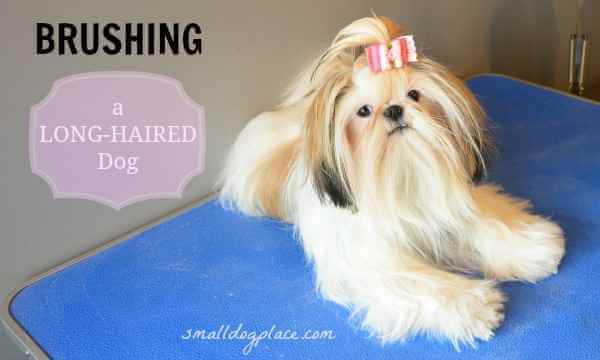 Training a Puppy for Grooming: Brushing
Training a Puppy for Grooming: BrushingYou should plan to brush your small breed dog’s hair frequently,
at least a couple of times per week, but preferably more often, even if the
hair does not require brushing as in the case with short haired breeds.
This frequent grooming not only gets the
puppy acclimated to the grooming process, but also gets him used to someone
touching his body—a skill he will need throughout his life when he visits the
veterinarian.
Read more about Dog Brushes (Review and Recommendations) or
Dog Combs (Recommendations)
How to Brush a Long-Haired Dog
Training a Puppy to Accept Nail Clipping
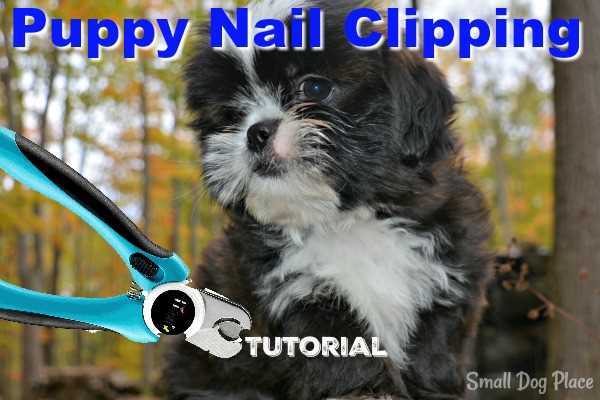 Training a Puppy for Grooming: Nail Clipping
Training a Puppy for Grooming: Nail ClippingMany puppies are skittish about getting their nails clipped. They may have had a bad experience before they came to live with you or they simply have had no experience at all.
The lucky ones are those that have come from caring breeders who clip their nails several times before they even reach the ripe old age of eight weeks. If your puppy is not one of these fortunate ones, don’t fret, all is not lost. You can train him to tolerate having his nails clipped.
Some of the problems associated with nail clipping is the fact that puppies may not appreciate your attempts to touch their paws. While some don’t care in the least, others are very nervous when someone starts to mess with their paws.
The first step is to get them accustomed to being touched all over the bodies and particularly their paws. If yours is one in this category, you will need to slowly acclimate them to nail clipping.
You can use a human nail clipper for tiny puppy nails or purchase a dog nail clipper that will work now and in the future.
Steps to Condition Your Puppy for Nail Clipping
- While holding or playing with your puppy, stroke, touch, or gently hold each paw. You can make a game of it if you prefer.W
“Got Your Paw”
“Touched your Paw”
“Gonna Get That Paw
- Once they feel comfortable with your touch, introduce the clippers. Squeeze the clippers in the air to allow the puppy to hear the sound of the nail clipper. Praise and give a small treat.
- Touch the clipper to the paw but do not clip the nail. Praise and give a treat.
- Finally, pick the paws that the puppy is least concerned with and clip the tip of the nails. Some puppies don’t mind the back nails being clipped, others will tolerate their front paws being held and nails clipped. Each puppy is different. Praise and give a treat.
- Gradually move to all four paws. Clip nails, praise and give a treat. Click here for more information on clipping your dogs nails.
Read more about Clipping Dog Nails or
How to Clip Puppy Nails or
How to Dremel Your Dog’s Nails
Giving Your Puppy a Bath
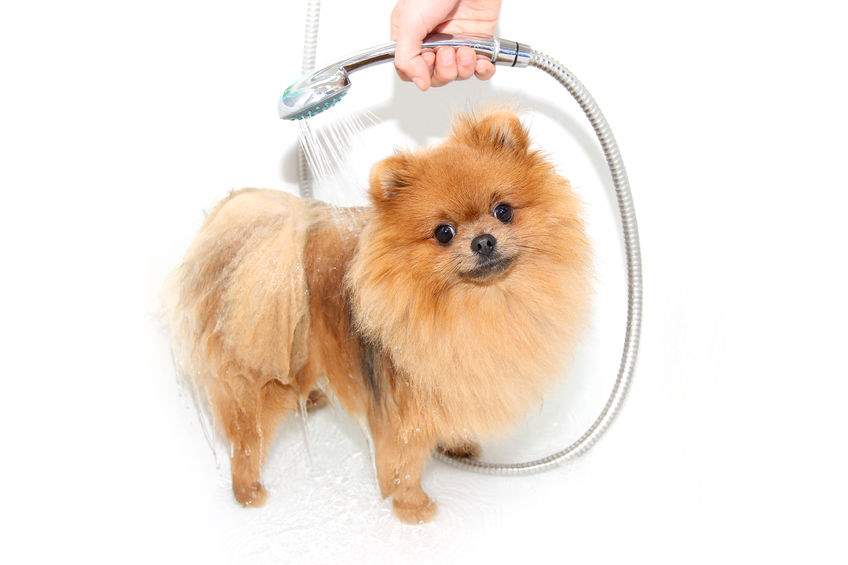 Training a Puppy for Grooming: Bath
Training a Puppy for Grooming: BathPuppies get dirty easily and may need more baths than adult dogs. Having a cooperative puppy can make the task enjoyable for both of you.
Chances are, however, if you are reading this now, you probably don’t have a docile puppy who loves bath time. There are tricks to use to assure you end up with a clean puppy that has not tried to escape and covered you with an unwanted shower. Sometimes management is just as easy as training a puppy for grooming.
- Chose a time when puppy is exhausted
- Assure the room is warm
- Use a small collar and leash if you have a puppy determined to escape, otherwise you will hold the puppy with one hand
- Line the tub or sink with a rubber mat
- Use a tear-less puppy shampoo
- Use a hand-held faucet head to wet puppy with warm but not hot water. Wet the head and ears last.
- Latter shampoo on the back, tail, stomach, paws and then move to the head.
- Hold the puppy with one hand and massage the shampoo with the other.
- Rinse back, legs, tail and stomach first, then the head, face, and ears last.
- Squeeze excess water from body, legs, tails, face and ears.
- Wrap puppy with a towel and allow to dry in the towel for several minutes before trying to dry with the towel and blow dryer.
- Blow dry using a cool to warm setting.
Read more about giving a puppy a bath
Puppy Shampoo is recommended because it is mild and won’t irritate delicate eyes.
(My favorite puppy shampoo is Isle of Dogs because it leaves the hair soft, shiny and smells divine.)
Takeaway (Training a Puppy for Grooming)
Training a Puppy for Grooming can be just as rewarding as teaching your little guy to walk on a leash or perform a trick. But just like housebreaking or teaching tricks, it does take time and patience. Consistency is the best advice.
Even if your puppy doesn’t need daily grooming, a short session once a day will teach your puppy that grooming is just part of the daily routine.
Recommended Reading
For Puppy Owners
For Puppy Groomers
Does This Article Deserve Your Thumbs Up?
We always appreciate your support and encouragement. Your thumbs up means so much to us.

Free Monthly Newsletter
Sign Up for Our Free Newsletter and get our Free Gift to You.
my E-book, The Top 10 Mistakes People Make When Choosing a Dog (and how to avoid them)
If you enjoyed this page, I’d love it if you’d let me know. Just click the button below. Thank you.
Sharing is Caring

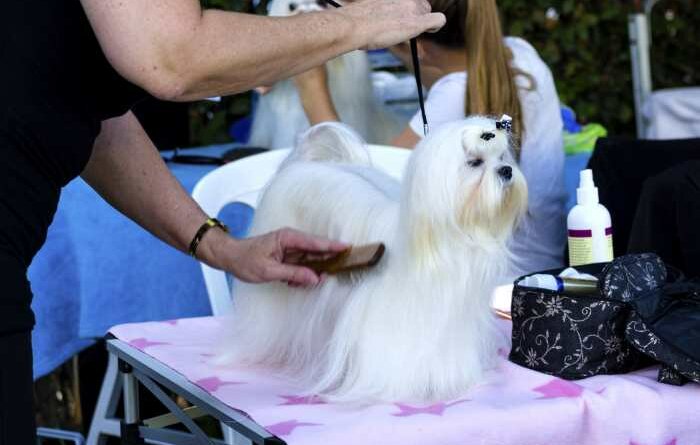

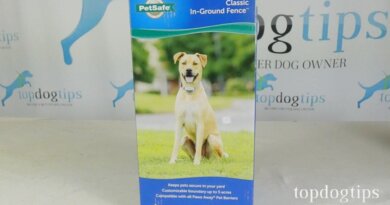
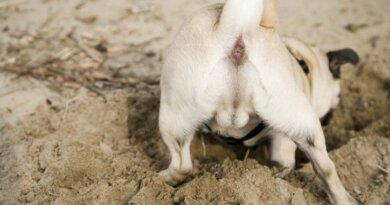
gel per erezione in farmacia: viagra generico recensioni siti sicuri per comprare viagra online
darkmarket url bitcoin dark web
best online canadian pharmacy review: legit canadian pharmacy top rated canadian online pharmacy
dark internet darknet websites
darknet drugs deep web drug store
dark web sites https://cypherdarkweb.com/ tor markets 2023
drugs from canada https://canadianpharm.pro/# canadian family pharmacy
new ed pills https://edpills.ink/# – treatment of ed
reputable indian online pharmacy: india pharmacy mail order pharmacy india
medicine in mexico pharmacies mexican drugstore online mexican rx online mexicanpharmonline.shop
paxlovid covid https://paxlovid.bid/ paxlovid price
Cheap Levitra online https://levitra.eus/# Levitra 10 mg best price
zithromax 250 mg australia https://azithromycin.bar/ where to get zithromax
ed treatment review https://edpills.tech/# best ed pills
ed treatment review ed medication buy erection pills edpills.tech
prednisone cost in india https://prednisone.bid/ buy prednisone from india
prednisone 5 mg tablet cost over the counter prednisone cream buy 10 mg prednisone prednisone.auction
darkmarket link [url=https://alldarknetmarkets.com/ ]darknet search engine [/url] dark web marketplaces
buy prednisone online uk https://prednisonepharm.store/ buy 40 mg prednisone
india online pharmacy https://indianpharmacy.shop/# – indian pharmacies safe indianpharmacy.shop
buying prescription drugs in mexico https://mexicanpharmacy.win/# mexican drugstore online mexicanpharmacy.win
meds online without doctor prescription https://edwithoutdoctorprescription.pro/ buy prescription drugs
diflucan otc uk https://diflucan.pro/ can you buy diflucan over the counter in mexico
aviator game bet: https://aviatorghana.pro/ aviator
Oscar Tur предлагает комфортабельные автобусные рейсы Горловки в Москву. Удобные сиденья, кондиционеры и опытные водители сделают вашу поездку приятной и безопасной.
Пошив штор на заказ Донецк
sweet bonanza taktik https://sweetbonanza.bid/ – sweet bonanza taktik
deneme veren slot siteleri https://slotsiteleri.guru/ en iyi slot siteleri
pin-up giriş: https://pinupgiris.fun/ pin-up giriş
aviator sinyal hilesi apk https://aviatoroyna.bid – aviator